 |
|
Focus features two in-depth reviews each month of fine art, architecture and design exhibitions and events at art museums, galleries and alternative spaces around Japan. The contributors are non-Japanese art critics living in Japan.
|
|
|
 |
 |
 |
Shapes, Colors, Textures, and Wisdom from Tohoku
Susan Rogers Chikuba |
 |
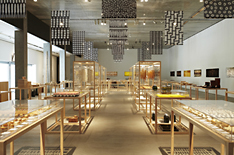 |
|
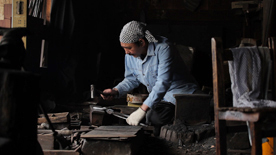 |
Fifty-five food and craft traditions of the Tohoku region fill 21_21 Design Sight's main gallery. Third-generation blacksmith Kozo Tazawa forges apple-pruning shears in Aomori Prefecture, balancing the blades to precision with a keen eye and experienced hands. It takes a full day to complete one pair.
Right photo: From "Films for Tema Hima: The Art of Living in Tohoku" © Tom Vincent / Yu Yamanaka
|
August is the last opportunity to catch Tema Hima: The Art of Living in Tohoku, an exhibition representative of the "back to basics" mood that's been spreading in Japan since the disasters of 3-11. In art spaces and other provocative venues throughout the country, more and more we encounter the question, "What are we chasing after, anyway -- might it be time to pull back, slow down, and reassess?"
Curated by graphic designer Taku Satoh and product designer Naoto Fukasawa, Tema Hima showcases tools for everyday living and foodstuffs made the traditional way, with no shortage of effort (tema) or time (hima) invested in their creation. Photography by Yusuke Nishibe and seven delightful film vignettes by Tom Vincent and Yu Yamanaka complement the displays, reiterating the show's themes of diversity, diligence, and craft.
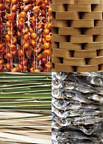 |
|
 |
| For everything there is a season: Tohoku's long snowbound months afford plenty of time for making preserves, tools, and crafts for use throughout the year. Nature's cyclic rhythms, of which people's steady preparations are a part, can be seen in landscapes and products alike. |
Six months in the making, the exhibition itself is an act of tema hima. Over the long Tohoku winter from late October 2011 until the exhibition's April launch, the Design Sight team visited some 90 sites in the region's six prefectures, meeting with farmers, craftspeople, and artisans to study, select, and document the foods and traditions on display. As if tracing those same journeys of discovery, one moves from the exhibition lobby, where monochrome photographs of far-off snowscapes hang, to a screening room showing films of people at work in their homes and studios, and finally to the main gallery, where photographs in warm, saturated colors show off the patterned details of Tohoku materials and handiwork, and row after row of tables display items ranging from dry-cured and fermented foodstuffs to basketry, pottery, and lacquerware. That progression -- from cold, remote distance to personal encounters to texture-ful objects you can actually smell -- is a pleasingly rich setup to a show that otherwise is very simple, even minimalistic, in its presentation. The point, one realizes, is that process -- the assembly and arrangement of things and the repeated cycle of preparation season after season, generation after generation -- is what the art of Tohoku living is all about.
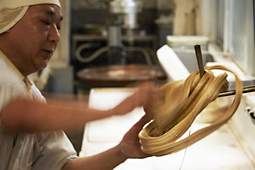 |
|
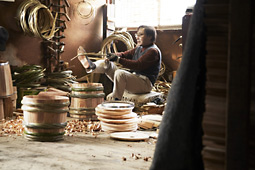 |
| With practiced hands, a confectioner at Ishibashiya of Miyagi Prefecture prepares natural mint candies made of unrefined cane sugar. In the making of cedar casks fitted with bamboo hoops, demonstrated here by Yoshio Hikage of Akita Prefecture, sometimes even the feet must be employed. |
|
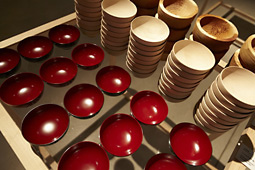 |
|
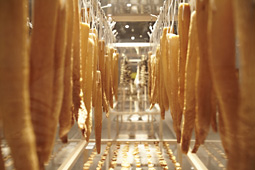 |
| Lacquerware made in Akita's Kawatsura is proudly used in the town's schools. Fukushima Prefecture's naturally freeze-dried kanboshi daikon radish is ready to eat when it turns amber in color. Harvested in the fall, buried underground until the first snowfall, soaked in water and hung to dry outside for two months, it sweetens simmered dishes. |
Exiting the gallery, one passes through a small room where a series of black-and-white photographs entitled "Anonymous Hands" covers two facing walls. Each one unique in its shape, look, and weathering, the hands are themselves a statement of genuine beauty. Captions identify not who they belong to but what it is they make, prompting all sorts of interesting connections. As the images wave you on your way, they seem to be asking: "What will you create, and how?"
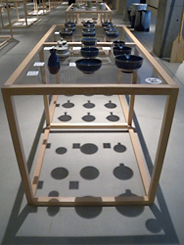 |
|
 |
The shadows formed by the objects on display are almost as eye-catching as the wares themselves. Shown here is Akita's Naraoka-yaki pottery, whose deep blue is rendered by mixing oak and straw ash into local clay. Photographer Yusuke Nishibe's presentation of 24 hands representing 13 professions tells as many stories, and more. Photographs by Susan Rogers Chikuba
All photographs are by permission of 21_21 Design Sight and unless otherwise noted are by Yusuke Nishibe. |
|
 |
 |
Susan Rogers Chikuba
Susan Rogers Chikuba, a Tokyo-based writer, editor and translator, has been following popular culture, architecture and design in Japan for 25 years. She covers the country's travel, hospitality, and culinary scenes for domestic and international publications. |
|
 |
|